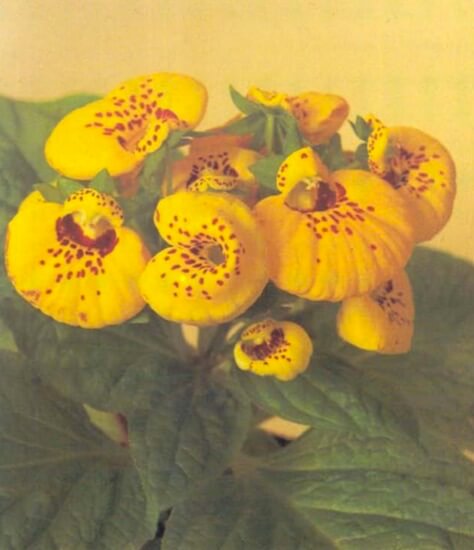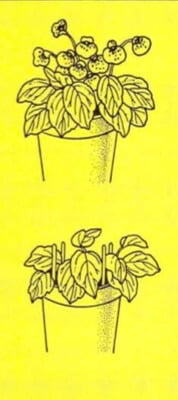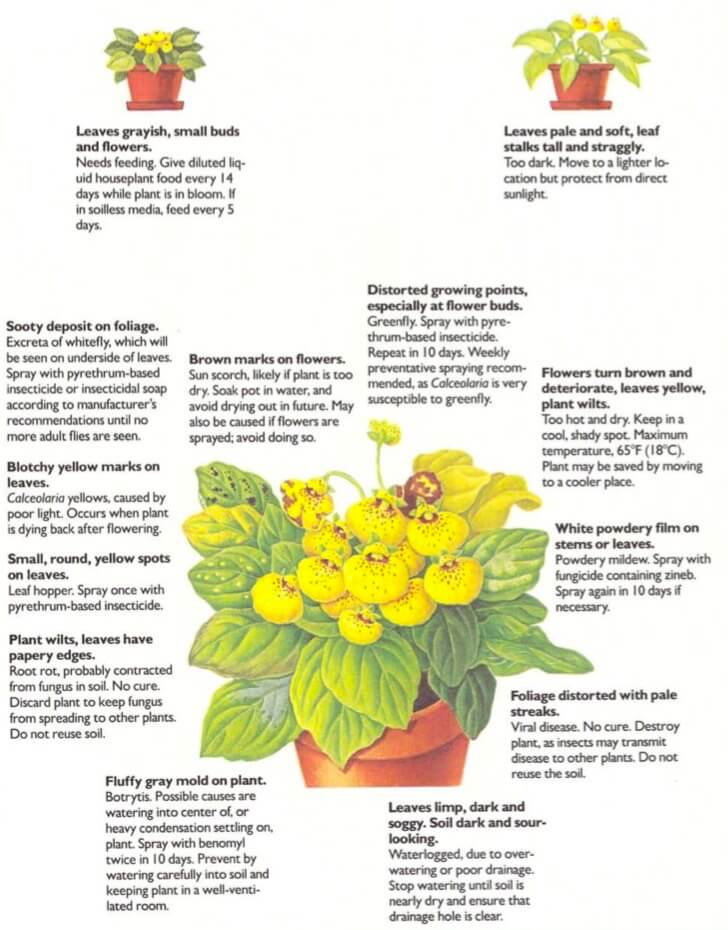[Ebook Việt Hoá] The Instant Guide to Healthy Houseplants (Hướng dẫn tức thời để chăm cây trong nhà khoẻ mạnh), Chi Calceolaria
[Ebook Việt Hoá] The Instant Guide to Healthy Houseplants: Calceolaria crenatiflora (Slipper flower, Lady’s slipper, Pocketbook plant)
- Nguồn: [Ebook Việt Hoá] The Instant Guide to Healthy Houseplants (Hướng dẫn tức thời để chăm cây trong nhà khoẻ mạnh)
- Biên tập: Dũng Cá Xinh
- Biên dịch: Team Codai.net
English
The Calceolaria is a native of the cool slopes of the Andes Mountains in South America. It needs similar conditions to survive as a houseplant and is therefore the ideal choice for a shady room or a windowsill out of the sun, where few other plants will thrive. Although it is possible to raise them from seed, they are usually sold already growing in a 6-in (15-cm) pot. Buy them just before the flowers completely open. Flowers should last 2-3 months in cool conditions but may wither in days if kept in dry, heated rooms. Keep the soil moist, but do not mist the leaves or flowers. The soft stems and leaves attract greenfly, particularly when the flower buds first appear. Treat immediately or the plant may not flower.

Light
Protect from direct sunlight at all times but give good light from late autumn to early spring. Keep in shade while flowering.
Temperature
Maximum, 50-55°F (10-13°C) for best flowering. Flowers deteriorate rapidly at temperatures over 65°F (18°C).
Water
2-3 times per week, water to keep soil moist but not waterlogged. Flowers will collapse if plant gets too dry. Water daily in very hot weather and make sure soilless media does not dry out.
Feeding
Feed with diluted liquid house- plant fertilizer every 14 days, using half the manufacturer’s recommended amount.
Humidity
Does best in fairly dry, well- ventilated rooms. Do not spray. If dusty, gently dust leaves and flowers with cotton swabs or a small paintbrush.
Soil
Use loam-based potting soil or soilless media.
After flowering
Plants are generally discarded after flowering is finished.
Support
- 1. When in full bloom, the plant is top heavy and may fall to one side.
- 2. In winter, before flowers appear, insert 4 small sticks around edge of pot. Later growth will hide them, and the plant will be held upright.

What Goes Wrong

- Leaves grayish, small buds and flowers: Needs feeding. Give diluted liquid houseplant food every 14 days while plant is in bloom. If in soilless media, feed every 5 days.
- Leaves pale and soft, leaf stalks tall and straggly: Too dark. Move to a lighter location but protect from direct sunlight.
- Sooty deposit on foliage: Excreta of whitefly, which will be seen on underside of leaves. Spray with pyrethrum-based insecticide or insecticidal soap according to manufacturer’s recommendations until no more adult flies are seen.
- Blotchy yellow marks on leaves: Calceolaria yellows, caused by poor light. Occurs when plant is dying back after flowering.
- Small, round, yellow spots on leaves: Leaf hopper. Spray once with pyrethrum-based insecticide.
- Plant wilts, leaves have papery edges: Root rot, probably contracted from fungus in soil. No cure. Discard plant to keep fungus from spreading to other plants. Do not reuse soil.
- Brown marks on flowers: Sun scorch, likely if plant is too dry. Soak pot in water, and avoid drying out in future. May also be caused if flowers are sprayed; avoid doing so.
- Distorted growing points, especially at flower buds: Greenfly. Spray with pyrethrum-based insecticide. Repeat in 10 days. Weekly preventative spraying recommended, as Calceolaria is very susceptible to greenfly.
- Flowers turn brown and deteriorate, leaves yellow, plant wilts: Too hot and dry. Keep in a cool, shady spot. Maximum temperature, 65°F (18°C). Plant may be saved by moving to a cooler place.
- Fluffy gray mold on plant: Botrytis. Possible causes are watering into center of, or heavy condensation settling on, plant. Spray with benomyl twice in I0 days. Prevent by watering carefully into soil and keeping plant in a well-venti- lated room.
- White powdery film on stems or leaves: Powdery mildew. Spray with fungicide containing zineb. Spray again in I0 days if necessary.
- Foliage distorted with pale streaks: Viral disease. No cure. Destroy plant, as insects may transmit disease to other plants. Do not reuse the soil.
- Leaves limp, dark and soggy. Soil dark and sour-looking: Waterlogged, due to over-watering or poor drainage. Stop watering until soil is nearly dry and ensure that drainage hole is clear.
Tiếng Việt
Calceolaria được tìm thấy từ các sườn núi mát mẻ của Dãy núi Andes ở Nam Mỹ. Nó cần những điều kiện tương tự để trồng trong nhà và là sự lựa chọn lý tưởng cho một căn phòng râm mát hoặc một bệ cửa sổ tránh ánh nắng mặt trời, nơi mà một số cây khác sẽ phát triển mạnh. Mặc dù có thể trồng từ hạt giống, chúng thường được bán khi đã trồng trong chậu 6 inch (15 cm). Mua cây trước khi hoa nở hoàn toàn. Hoa có thể để được 2-3 tháng trong điều kiện mát mẻ nhưng có thể héo vài ngày nếu giữ trong phòng khô và có sưởi. Giữ đất ẩm, nhưng không phun sương lên lá hoặc hoa. Thân và lá mềm sẽ thu hút ruồi xanh, đặc biệt là khi nụ hoa mới nhú. Xử lý ngay nếu không cây có thể không ra hoa.

Ánh sáng
Bảo vệ khỏi ánh nắng trực tiếp mọi lúc nhưng cuối mùa thu đến đầu mùa xuân cần ánh sáng tốt. Giữ trong bóng râm khi ra hoa.
Nhiệt độ
Tối đa 50-55 ° F (10-13 ° C) để ra hoa tốt nhất. Hoa hỏng nhanh chóng ở nhiệt độ trên 65 ° F (18 ° C).
Nước
Mỗi tuần tưới 2-3 lần để giữ ẩm cho đất nhưng không bị úng. Hoa sẽ tàn nếu cây quá khô. Tưới nước hàng ngày khi thời tiết quá nóng và đảm bảo đất trồng không bị khô.
Bón phân
Sử dụng phân bón hữu cơ dạng lỏng pha loãng cứ 14 ngày một lần, sử dụng nửa lượng khuyến cáo của nhà sản xuất.
Độ ẩm
Tốt nhất trong các phòng khô ráo, thông gió tốt. Không xịt. Nếu có bụi, hãy nhẹ nhàng quét bụi trên lá và hoa bằng tăm bông hoặc cọ nhỏ.
Đất
Sử dụng bầu đất mùn hoặc môi trường không đất.
Sau khi ra hoa
Cây thường bị loại bỏ sau khi kết thúc ra hoa.
Cột chống
- 1. Khi nở rộ, cây nặng đầu và có thể đổ sang một bên.
- 2. Vào mùa đông, trước khi hoa nở, cắm 4 que nhỏ xung quanh mép chậu. Sự phát triển sau này sẽ ẩn chúng đi và cây sẽ được giữ thẳng đứng.

Những vấn đề có thể xảy ra

- Lá màu xám, nụ và hoa nhỏ: Cần nuôi dưỡng. Sử dụng phân bón hữu cơ dạng lỏng pha loãng cứ 14 ngày một lần khi cây đang ra hoa. Nếu trong môi trường không có đất, hãy bón phân 5 ngày một lần.
- Lá tái nhợt và mềm, cuống lá cao và mọc lệch: Quá tối. Di chuyển đến vị trí sáng hơn nhưng tránh ánh nắng trực tiếp.
- Cặn đen trên tán lá: Chất thải của ruồi trắng, sẽ được nhìn thấy ở mặt dưới của lá. Phun thuốc trừ sâu hoặc xà phòng diệt côn trùng pyrethrum theo khuyến cáo của nhà sản xuất cho đến khi không còn thấy ruồi lớn nữa.
- Các vết vàng có đốm trên lá: Calceolaria vàng do ánh sáng kém. Xảy ra khi cây khô héo sau khi ra hoa.
- Trên lá có đốm nhỏ, tròn, vàng: Rầy. Phun một lần bằng thuốc diệt côn trùng pyrethrum.
- Cây bị héo, mép lá mỏng: Thối rễ, có thể do nấm trong đất. Không có thuốc chữa. Vứt bỏ cây để ngăn nấm lây lan sang các cây khác. Không tái sử dụng đất.
- Vết nâu trên hoa: Cháy nắng, có thể là do cây quá khô. Ngâm chậu trong nước để tránh bị khô trong thời gian tới. Cũng có thể bị nếu hoa bị phun thuốc; tránh làm như vậy.
- Các điểm phát triển méo mó, đặc biệt là ở nụ hoa: Ruồi xanh. Phun thuốc diệt côn trùng pyrethrum. Lặp lại trong 10 ngày. Nên phun thuốc phòng ngừa hàng tuần, vì Calceolaria rất dễ bị ruồi xanh.
- Hoa chuyển sang màu nâu và xấu đi, lá vàng, cây héo: Quá nóng và khô. Giữ ở nơi mát mẻ, râm mát. Nhiệt độ tối đa là 65 ° F (18 ° C). Có thể cứu cây bằng cách chuyển đến nơi mát hơn.
- Nấm mốc xám trên cây: Bệnh nấm mốc. Nguyên nhân có thể là do nước tưới vào giữa cây, hoặc nước ngưng tụ đọng lại trên cây. Phun benomyl hai lần trong 10 ngày. Ngăn ngừa bằng cách tưới nước cẩn thận vào đất và giữ cây trong một căn phòng thông gió tốt.
- Màng phấn trắng trên thân hoặc lá: Bệnh phấn trắng. Phun thuốc diệt nấm có chứa zineb. Phun lại sau 10 ngày nếu cần thiết.
- Tán lá méo mó với những vệt nhạt màu: Bệnh do virus. Không có thuốc chữa. Phá hủy cây trồng vì côn trùng có thể truyền bệnh cho các cây khác. Không sử dụng lại đất.
- Lá mềm nhũn, sẫm màu và sũng nước. Đất sậm màu và chua: Bị úng nước, do tưới quá nhiều hoặc thoát nước kém. Ngừng tưới nước cho đến khi đất gần khô và đảm bảo lỗ thoát nước thông thoáng.
![[Ebook Việt Hoá] The Instant Guide to Healthy Houseplants: Calceolaria crenatiflora (Slipper flower, Lady’s slipper, Pocketbook plant) [Ebook Việt Hoá] The Instant Guide to Healthy Houseplants: Calceolaria crenatiflora (Slipper flower, Lady’s slipper, Pocketbook plant)](https://vn1.vdrive.vn/codai.net/2020/02/calceolaria-herbeohybrida-2.jpg)


